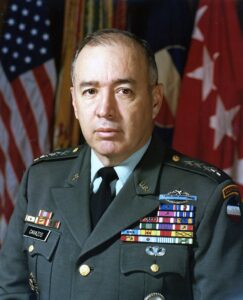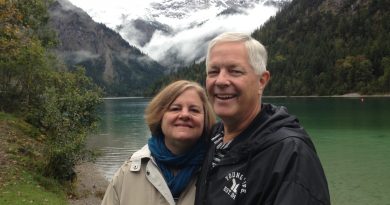New Name, Same Place
FORT HOOD TO BECOME FORT CAVAZOS IN MAY
By JANNA ZEPP | Photo from the U.S. ARMY
 Fort Hood will become Fort Cavazos in May.
Fort Hood will become Fort Cavazos in May.
Now before y’all get upset and send me tersely worded emails and leave spicy voicemails on my phone, understand that I have a deep, personal connection with Fort Hood. Not only did I work there for four incredible years, my maternal grandfather, Curtis “Tex” Williams was stationed there as an 86th Infantry Division “Blackhawk,” which was a part of III Corps during World War II. In 1944, while Grandpop was there, we called it Camp Hood.
My mother and maternal grandmother visited him while he was there for a weekend before he went off to war in Europe and later, the Pacific Theater. Mom always associates Doris Day’s singing “Sentimental Journey” with Camp Hood. Nine months after that visit, my Aunt Mary was born. My grandmother occasionally referred to Mary as her “Camp Hood souvenir.” I was in my late twenties when it dawned on me why Grammo Williams called her that. I had to think about sandpaper and bleach for about a week after that. Now, I just cackle with laughter.
Now, let’s talk about Gen. Richard Cavazos, the first Hispanic four-star general in Texas, for whom the Great Place will now be named.
Richard Edward Cavazos (Jan. 31, 1929 – Oct. 29, 2017) was a Korean War recipient of the Distinguished Service Cross as a first lieutenant and advanced in rank to become the U.S. Army’s first Hispanic four-star general. During the Vietnam War, as a lieutenant colonel, Cavazos was awarded a second Distinguished Service Cross. In 1976, Cavazos became the first Mexican American to reach the rank of brigadier general. Cavazos served for 33 years, with his final command as head of the United States Army Forces Command.
Cavazos was born in Texas, grew up on the King Ranch and died in Texas. He was a Texan. He was one of us.
Gen. Cavazos earned a Bachelor of Science in geology from Texas Technological College (now Texas Tech University) in 1951, where he played on the football team and was a distinguished graduate of the ROTC program. He received further military education at the Command and General Staff College, the British Army Staff College, the Armed Forces Staff College and the United States Army War College. He received basic officer training at Fort Benning, Georgia, followed by training at Airborne School.
His brother is former Texas Tech University president and former U.S. Secretary of Education Lauro Cavazos. That’s an impressive family right there.
During the Korean War, as a member of the 65th Infantry Regiment, a unit of mostly natives of Puerto Rico, he distinguished himself, receiving both the Silver Star and Distinguished Service Cross for his heroic actions.
On Feb. 25, 1953, Cavazos’s Company E was attacked by the enemy. During the fight against a numerically superior enemy force, Cavazos distinguished himself and received the Silver Star after his company won the battle. On June 14, 1953, Cavazos again distinguished himself during an attack on Hill 142 and was awarded the Distinguished Service Cross for his heroic actions on that day.
On Sept. 10, 1953, per General Orders No. 832, Cavazos was awarded the Distinguished Service Cross for his actions during the Korean War.
In February 1967 in Vietnam, Cavazos, then a lieutenant colonel, became commander of the 1st Battalion, 18th Infantry Regiment. In October and November 1967, his battalion was engaged in fighting near the Cambodian border. During an attack at Loc Ninh in October 1967, his unit was able to repulse the enemy. For his valiant leadership at Loc Ninh, he was awarded a second Distinguished Service Cross.
On Dec. 17, 1967, per General Orders No. 6479, Cavazos was awarded his second Distinguished Service Cross for his actions on Oct. 30, 1967.
After Vietnam, Cavazos served as commander of the 2nd Brigade, 1st Infantry Division, and commander, 9th Infantry Division.
In 1976, Cavazos became the first Hispanic to reach the rank of brigadier general in the United States Army. In 1980, he became commander of III Corps at Fort Hood.
In 1982, Cavazos again made military history by being appointed the army’s first Hispanic four-star general. The same year, Cavazos assumed command of the United States Army Forces Command. His early support for the National Training Center and his involvement in the development of the Battle Command Training Program enormously influenced the war fighting capabilities of the United States Army.
On June 17, 1984, after 33 years of distinguished service, Cavazos retired.
In 1985, Cavazos was appointed to the Chemical Warfare Review Committee by President Ronald Reagan. He also served on the Board of Regents of his alma mater, Texas Tech.
Cavazos’s actions, guidance and loyalty to the soldiers he served with led retired Lt. Gen. Daniel P. Bolger to declare him the epitome of “Army done right.”
While Cavazos was certainly a fearless soldier, he is also remembered as a beloved mentor and teacher. His determination to share what he learned throughout his career made him influential in the development of the Army’s Battle Command Training Program for high-ranking officers (now Mission Command Training Program). Gen. Colin Powell credited Cavazos for helping him after a less than stellar performance evaluation had Powell reconsidering his Army career.
But it was the countless Hispanic soldiers who followed in his footsteps who credit Cavazos for paving the way for their careers. “I told him what he meant to us poor Hispanic kids,” recalled Maj. Gen. Alfred Valenzuela. “His impact as a mentor is probably the greatest impact our army had…we all looked up to him as an American soldier, a Hispanic soldier. He was the guy we wanted to be. If we couldn’t be him, we wanted to be near him and serve with him.”
Cavazos tried to bring back as many of his soldiers as he possibly could. He clearly cared about the soldiers under his command. That is bravery. That is valor. That is human decency toward others. And that name is worthy of being on one of the largest military installations in the world known as the Great Place.
Gen. John Bell Hood is in no danger of disappearing from history just because his name is no longer on our U.S. Army post in West Bell County. There is a John Bell Hood Museum up in Hillsboro that folks are welcome to visit and learn more about him. He’s in the history books. The American Civil War will always be taught in our public schools, because if we fail to learn history, especially in depth, we are doomed to repeat it. And Fort Cavazos, as the Great Place will soon be called, will always have a place in my family’s personal history from when it was Camp Hood and then Fort Hood. But I am looking forward to a fresh renaissance for the Great Place, and all the eventual changes to evolve our military out of the past and into the future. The future, for all of us including our Great Place, looks inclusive and very, very bright.


